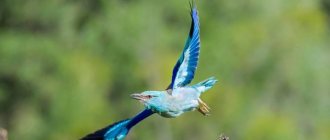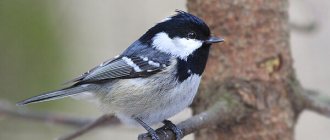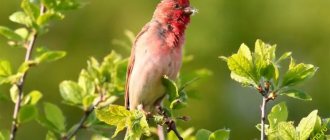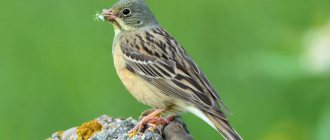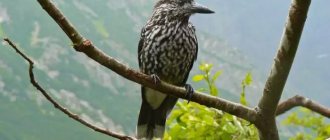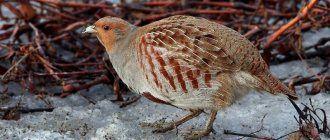- Wild animals
- >>
- Birds
The puffin bird is a cute arctic animal whose appearance and movements look funny. It moves along the ground, holding its body vertically, comically rearranging its short legs. When a bird comes in to land, it frantically flaps its small wings, trying to stay in the air, and stretches out its legs, like a landing gear, braking with them. Puffins live in colonies and are very curious and tame birds that can perform unexpected pirouettes in flight.
Varieties
Ornithologists distinguish 3 subspecies of puffins, differing in habitat and size:
- Fratercula arctica arctica – Canada, northeastern USA, southwestern Greenland, Iceland, Norway east to Kola and Novaya Zemlya;
- Fratercula arctica grabae – Faroe Islands, northern Norway, British Isles, northwestern France;
- Fratercula arctica naumanni - northern Iceland, south of Spitsbergen and northern Novaya Zemlya.
Representatives of the first subspecies are medium in size, the second subspecies are the smallest, and the third are the largest.
Origin of the species and description
Photo: Bird puffin
The puffin is a species of marine birds found in the order Charadriiformes and belonging to the auk family (Alcidae). The Atlantic puffin is the only species of the genus Fratercula living in the Atlantic Ocean. Two other species are found in the northeastern Pacific region: the puffin (Fratercula cirrhata) and the puffin (Fratercula corniculata), the latter of which is the Atlantic puffin's closest relative. The rhinoceros puffin (C. monocerata) and the Atlantic puffin are also closely related. Fossils have been found of the puffin's extinct closest relative, the Pleistocene bird Fratercula dowi.
Video: Bird puffin
The generic name Fratercula comes from the medieval Latin word Fratercula (monk), as the black and white plumage of the bird is reminiscent of monastic robes. The specific name arctica comes from the Greek ἄρκτος (“arktos”), bear, and refers to the constellation Ursa Major. The Russian name “dead end” refers to the bird’s massive beak and comes from the word “dumb.”
There are three generally recognized subspecies:
- F. arctica arctica;
- F. arctica naumanni;
- F. arctica grabae.
The only morphological difference between them is their parameters. Body length + beak size + wing length, which increases at higher latitudes. For example, the puffin from northern Iceland (subspecies F. a. Naumanii) weighs about 650 g and has a wing length of 186 mm, while a representative of the Faroe Islands ( subspecies F. a. Grabae) weighs 400 g and has a wing length of 158 mm. Individuals from southern Iceland (subspecies F. a. arctica) are intermediate between the two.
Spread range
Most puffins nest in colonies on small islands where there are no mammalian predators such as mink and fox. Some of them nest along the shores of the Atlantic Ocean in the Northern Hemisphere, where they gain protection from predators by choosing safe spots on rocks. Thousands and sometimes hundreds of thousands nest together in large colonies. The largest concentrations of puffins have been observed on islands around Iceland, Norway, the Faroe Islands, the British Isles and eastern Canada. About 500,000 pairs breed in North America from northern Maine in the United States to the Canadian Arctic. Currently, about 60% of the North American population nests on four islands in Witless Bay off the east coast of Newfoundland.
Photo: Wikipedia
Puffins spend winters throughout the North Atlantic far from land. They can be seen, mostly alone , anywhere from the edge of the Arctic pack ice in the north to New York City in the west and the Canary Islands off northern Africa in the east. In Russia they can be found on the Ainovsky Islands (Murmansk region), Novaya Zemlya and the Kola Peninsula.
- Biogeographic regions: ocarctic, palearctic
About the lifestyle and how cute puffins are
In the spring, the birds return to where they were born and are also going to build nests (but first they will wait, swimming near the shore and waiting for the ground to thaw). The best place is the one from which you can take off quickly. And the fish will be safe there - it’s more difficult for seagulls and skuas to steal them. There is only one partner at the dead end, someone he likes. The mating ceremony is very cute - puffins approach each other, swaying slightly, and then rub their beaks. The male brings small fish to his beloved, trying to prove that he can provide a comfortable life for her and the chicks.
Character traits
Appearance
The puffin is one of the most famous seabirds and its colorful images often appear on calendars and posters. In 1992, the puffin became the official bird of the province of Newfoundland and Labrador. Most people only recognize the puffin when it is "dressed" in its bright plumage during the breeding season, and are unlikely to recognize it in its simpler winter "clothing".
Photo: Hans-Jurgen Mager
The breeding adult has a striking orange-red-gray bill and bright orange feet. The triangular beak is wide in profile and narrow in the transverse direction. The gray and white face of the puffin is decorated with yellow rosettes at the base of the beak, red rings and small bluish-gray plates around the eyes. The upper parts, including the head, back and wings, are black and contrast sharply with the bright white lower part of the body.
At the end of the breeding season, the adult puffin sheds the colorful plates on its beak and around the eyes, as well as the feathers on its head and neck. His face becomes dark, especially around and in front of his eyes. The puffin changes color so dramatically in winter that ornithologists once thought it was a completely different species of seabird.
In late winter and spring, the puffin loses its ability to fly for a short time, replacing its flight and tail feathers, which after a year of use have become severely worn out.
Immature puffins are similar to adult winter puffins, but have smaller and sharper beaks. Adults in winter plumage and immature puffins are sometimes confused with guillemots.
Anatomical features
They are compact, strong birds with a relatively long body. They have short wings with powerful muscles . At one end, the beak and head cut through the water, which flows smoothly along the streamlined body, and at the other end, the legs and feet act as rudders. So puffins are perfectly adapted to swimming underwater.
Puffins are bad flyers . They have difficulty getting airborne and must beat their wings at 300 to 400 beats per minute to maintain flight. They also have trouble landing and often crash into seawater or fall onto the grass, landing on other puffins that get in their way.
On land, puffins stand upright and walk or jump with great caution over the colony's uneven terrain. These birds are very curious . Researchers have often observed how a fighting pair of puffins was surrounded by a crowd of fellow onlookers.
Dimensions
Both sexes look similar, although males tend to be slightly larger than females. Body length varies from 30 to 35 cm, body weight does not exceed 650 grams. The beak length is about 4-5.5 cm, the wingspan is on average 50 cm.
Appearance and features
Photo: Northern bird puffin
The Atlantic puffin is strongly built, with a large neck, short wings and tail. It measures 28 to 30 cm in length from the tip of its thick beak to its blunt tail. The wingspan ranges from 49 to 63 cm. The male is usually slightly larger than the female, but of the same color. The forehead and back of the head are glossy black, as are the back, wings and tail. Wide black collar located around the neck. On each side of the head is a large, diamond-shaped area that is pale gray in color. These spots on the face taper to a certain point and almost meet at the back of the neck.
The beak looks like a triangle from the side, but when viewed from above it is narrow. The half near the tip is orange-red and the half near the head is slate gray. The exact proportions of the beak vary depending on the age of the bird. An immature bird's beak is not as wide as an adult bird's. Over time, the beak deepens, the upper edge bends, and a fracture develops at its base. The bird has a strong bite.
Interesting fact: The beak is important in attracting a mate. During the breeding season in spring, the characteristic bright orange color of the beak appears.
The eyes appear almost triangle-shaped due to a small, pointed area of horny blue-gray skin near them and a rectangular patch below. The pupils are brown or dark blue, and each has a red orbital ring. The lower part of the bird is covered with white plumage. By the end of the breeding season, the black plumage loses its shine and even acquires a brown tint. The legs are short and well laid back, providing the bird with a straight stance on land. Both legs and large webbed feet are bright orange, contrasting with sharp black claws.
Lifestyle
Puffins are true seabirds, spending most of their time swimming, diving and feeding on the water. For about four to five months each year they come onto land to breed, but even then they spend a lot of time at sea . Typically, puffins stick to the same partner and the same nest from year to year.
Photo: Wynand van Poortvliet
At the beginning of the mating season, many birds “hunt for home”, and the owners have to defend their territories. Usually, to scare away newcomers, it is enough to fluff up the feathers, open the beak and display other threats. Otherwise, fights break out and it is not uncommon to see two puffins falling down a slope with their beaks locked together.
Observers are often impressed by large groups flying in wide circles over the sea in front of their nesting sites. These dead-end "wheels" are common in most colonies, but are more common in colonies where there are many predators. This is likely an anti-predator tactic, confusing or overwhelming the intruder and reducing the likelihood of an individual puffin being killed (or its prey stolen). Puffins returning to or leaving the colony may join the "wheel" and then land near their burrow or on the sea surface.
Interesting Facts
- It is interesting that if one dead-end bird gets scared of something and quickly takes off, then the entire colony takes off after it. They look around for a while and then return to their place.
- Puffins have such a colorful appearance that they are often depicted on postage stamps, on the logos of book publishers, some islands are named after them, and they are also the official symbol of the Canadian provinces of Newfoundland and Labrador.
- To take off, they must climb a sheer cliff and fall from there. Then, already in the air, they flap their wings intensively, gaining height. It's funny to watch these birds line up at such a precipitous place.
- These small birds can make significant, non-stop flights. It is common for them to cover a distance of 200-300 km.
- The devotion of both parents to their children is surprising; even their father always takes care of the offspring if the mother unexpectedly dies.
Diet
Puffins eat small marine animals, preferring fish such as capelin, sand lances and herring. Other fish, as well as crustaceans, molluscs, squid, shrimp and sea worms, are caught when the main prey is less available.
While feeding, the bird swims on the surface of the sea like a duck and then dives headfirst under the water . The puffin probably floats in the water until it reaches a depth at which its prey can be caught. It grabs suitable fish or other food items one by one with its powerful beak before returning to the surface.
Adults hold the fish across their beaks , carrying food to their chicks. Chicks are usually fed about 10 grams of food four to ten times a day, mostly in the morning. Adults usually carry only one or two capelin or gerbils measuring 12-15 cm at a time, but more if the fish are smaller. The record observed number of fish held by a puffin at one time was 61. They were 2.3 to 3.3 cm long larval gerbils that together weighed just 2.3 grams, about the same as half a teaspoon of water.
Photo: Glen Hooper
How can a puffin catch and hold 61 fish in its beak? , a series of rear-facing spines protrude from the tongue and the top of the mouth , which hold food in place while the bird catches its next prey.
Reproduction and lifespan
Having returned from wintering, they do not immediately begin to build nests, but swim near the shore for some time, waiting for the ground to thaw. And only then do they begin construction. Although often they do not build, but occupy last year’s burrows, where they have already bred offspring with the same pair.
All the puffins try to arrive early to get the best seat, especially interested in the possibility of takeoff. They must have convenient access to the launch site. In addition, it is necessary to provide protection from attacks by egg hunters, seagulls and skuas.
The construction of a new hole or the repair of an old one occurs as follows - one bird stands guard, the second carries out excavation work, then the first takes the excavated soil from it. Coordinated and efficient. Together they find and collect grass material to line the hole.
Of course, the soil should not be very hard, like peat. After all, they dig with their paws and beak. The passages are usually in the form of arcs, less often straight, up to 3 meters long. Sometimes tunnels dug by different families intersect with each other.
Having made a hole, they begin to take care of their feathers again, periodically quarreling with their neighbors. These fights are not aggressive, rather for status. Social status is not an empty phrase for them. It is important that personal territory is reliably protected. In quarrels, no one suffers, no one gets seriously injured, a couple of pecks and that’s it. As long as the ritual is followed.
Puffins create burrow-like nests
These birds are monogamous; they try to return to the same hole and with the same pair for several years. It is still unknown when they find a pair - at the winter quarters or already in the settlement. During courtship, they walk swaying next to each other, and then the main love ritual begins.
They gently rub each other with their colorful beaks. A boyfriend feeds his girlfriend small fish, trying to win her affection. At the same time, he confirms that he can become the breadwinner of a future family. Usually there is only one egg in the nest, measuring 6*4 cm, weighing 60-70 g. It is pure white, soft lilac specks rarely appear on the shell.
Both partners incubate for approximately 5 weeks. The chicks appear covered with black down, weigh about 42 g, but gain weight very quickly, 10 g per day. Parents do everything for this; they fly for food up to 10 times a day. Both parents are equally attached to the chick.
They are ready to be on limited food themselves, but to feed the cub to the full. On the 10th-11th day, all the chicks in the settlement begin to develop their first winter feathers. They fly out of the nest at the age of 5-6 weeks under night cover, when there are fewer predators.
They are already all covered with feathers and fly well. The lifespan of this funny bird is simply amazing; according to preliminary data, they live for about 30 years. Today, the Atlantic puffin is listed as vulnerable on the IUCN Red List.
Reproduction
Breeding season
It takes four to five years before the puffin is mature enough to reproduce. Most puffins prefer to nest on grassy slopes in burrows ranging from 50 to 200 cm long, which they dig with their beaks and sharp claws on their feet. Some birds nest in cracks under boulders or in rock crevices, especially in arctic colonies where there is little soil or where the soil remains frozen for much of the summer. After clearing out their burrows, many puffins line their nests with grass, twigs and feathers. The slightly enlarged nesting chamber in which the egg is laid is usually located at the end of the burrow.
The laying season begins as early as April in more southern colonies and lasts until June in more northern groups. Courtship of a female occurs mainly on the water, where males throw back their heads, puff out their chests and flap their wings to attract the attention of females. Sometimes the male brings small fish in his beak to a potential partner, thereby demonstrating his ability to feed his family.
Billing is one of the most common behaviors in a puffin colony. It involves a pair looking at each other and repeatedly pressing their beaks together while rapidly shaking their heads from side to side.
After a period of courtship and mating, the female puffin lays a single egg, representing about 14% of her weight. The egg starts out whitish with faint spots, but quickly turns brown due to dirt and dust. As with some penguins, both parents take turns incubating the egg , which hatches after about six weeks.
- Age of sexual or reproductive maturity: 4 to 5 years
- Mating system: monogamy
- Mating season: mid-spring – early summer, depending on nesting site
Chick development
The newly hatched chick is covered in soft down, gray-black on the back and head and white on the belly, and weighs about 40 grams . The parents should keep it warm for the first week until the chick can maintain its own body temperature. He is then left alone in a safe place most of the time while both parents come and go, bringing him food.
The chick grows quickly if there is a lot of food. After four or five weeks it reaches a peak weight of 250 to 350 grams and replaces its downy coat with plumage. The chicks usually complete the process of growing their flight feathers and leave the nest when they are about 40 days old, but this process can take up to 80 days if food is scarce.
Most of the fledged chicks fly away under the cover of darkness and by morning they find themselves at sea, far from the colony. Many chicks die if there is very little food. Breeding success varies greatly between years and even between colonies, but is typically between 60 and 90 percent.
- Number of eggs in a clutch: one egg
- Incubation period: 35-36 days
Features of character and lifestyle
Photo: Puffin bird in flight
The Atlantic puffin has a straight flight, usually 10 m above the sea surface, higher than most other birds. It walks upright, makes a low, purring sound in flight, and during nesting the sounds resemble grunts and moans. Atlantic puffins are solitary when at sea, and this part of their life is little studied, since the task of finding even one bird in the vast ocean is difficult.
When at sea, the Atlantic puffin bobs like a cork, propelling itself with powerful kicks through the water and holding itself up in the wind even when resting and apparently sleeping. Every day he spends a lot of time cleaning to keep his plumage in order. Its down underlay stays dry and provides insulation.
Fun Fact: Like other seabirds, its upper plumage is black and its lower plumage is white. This provides protective camouflage as aerial predators cannot see it against the dark, watery background, and underwater attackers miss the bird as it blends into the bright sky above the waves.
When a puffin takes off, it flaps its wings vigorously before launching into the air. The wing size is adapted for dual use, both above and below water, its surface area is small compared to the weight of the bird. To maintain flight, the wings beat very quickly at a speed of several times per second. The bird flies straight and low over the surface of the water and can travel at speeds of 80 km per hour.
The landing is awkward, he either crashes into the crest of a wave, or falls on his stomach in calm water. While at sea, the Atlantic puffin moults. It sheds all its feathers at once and goes without flying for about a month or two. Molting usually occurs between January and March, but young birds may lose their feathers a little later.
Threats and conservation status
Puffins are one of the most common seabirds in the Northern Hemisphere. Recent estimates place the global population at about 12 million breeding birds or about 24 million puffins , including young birds that have not yet reached reproductive age.
Photo: Ray Hennessy
The main predators of puffins are other birds and people; other mammals usually cannot access isolated breeding colonies. The great black-backed gull is the main predator of adult puffins. Herring gulls, which are smaller in size, prey on chicks but pose no threat to adults.
Hunting, egg collection, and habitat destruction are severely depleting many puffin colonies. Thousands of puffins drown each year in fishing nets designed to catch fish such as salmon and cod. Oil pollution has also always been a threat to puffins and albatrosses, as they spend most of their time on the surface of the ocean.
Puffins may also suffer from food shortages caused by overfishing, as well as natural climate and oceanographic changes that reduce the abundance of important prey species.
Natural enemies of puffin birds
Photo: Bird puffin
Birds are safest at sea. You can often see the puffin sticking its head under the water to see if there are predators nearby. It is known for sure that seals kill puffins, and any large predatory fish can also do this. Most colonies are located on small islands, and this is no coincidence, since it avoids predation by land mammals: foxes, rats, stoats, weasels, etc. But when birds come ashore, they are still in danger, since the main threat comes from sky.
Predators of the Atlantic puffin in the sky include:
- sea gull (L. marinus);
- great skua (Stercorarius skua).
As well as other species of similar size that can catch a bird in flight or attack birds that cannot escape quickly on the ground. When they detect danger, puffins take off and fly down to the sea or retreat to their burrows, but if caught, they vigorously defend themselves with their beaks and sharp claws. When puffins circle near the rocks, it becomes very difficult for a predator concentrating on one bird to catch them, while individuals isolated on the ground are at greater risk.
Interesting fact: Ixodid ticks and fleas (Ornithopsylla laetitiae) have been found in puffin nests. Other flea species found on birds include C. borealis, C. gallinae, C. garei, C. vagabunda and the common flea S. cuniculi.
Small gull species such as the herring gull (L. argentatus) are unlikely to knock down an adult puffin. They pass through the colony, collecting eggs or hatchlings that have strayed too far from the nest towards daylight. These gulls also steal fish from puffins returning to feed their young. In places where the puffin and the short-tailed skua (S. parasiticus) nest together, the latter becomes a terrestrial predator. In the air, it harasses puffins, forcing them to drop their prey, which it then snatches.
Did you know?
- Puffins make loud, growling calls that sound like the muffled sounds of a chainsaw.
- Puffins rarely fly higher than 10 meters above the surface of the water, but their speed can reach 80 km/h !
- The bird got its name “dead end” because of its massive rounded beak.
- Puffins can dive for up to a minute, although they usually only stay underwater for about 30 seconds. This seabird can dive to depths of up to 60 meters .
- Every year, half a million puffins are netted in Iceland and the Faroe Islands to sell their meat and feathers.
- Puffins are very social birds , forming large colonies together. The largest documented colony is located on the Vestmann Islands in Iceland. Scientists estimate there were 4 million birds here.
- In the wild, puffins live for about 20 years. The oldest known puffin lived to be 36 years old !
- According to ornithologists, in the coming decades the European population may lose up to 2/3 of its size.
What does the puffin bird eat?
Photo: Puffin seabird
The Atlantic puffin's diet consists almost entirely of fish, although examination of the stomach contents shows that the bird occasionally eats shrimp, other crustaceans, molluscs and polychaetes, especially in coastal waters. When fishing, the puffin swims underwater, using its elongated wings as a paddle to "fly" underwater and its legs as a rudder. It swims quickly and can reach considerable depths and remain underwater for up to a minute.
The bird eats small fish up to 18 cm long, but the prey is usually smaller fish, about 7 cm long. An adult bird should eat about 40 fish per day - eels, herring, sprats and capelin are the most commonly consumed. The puffin can swallow small fish while underwater, but larger specimens are brought to the surface. It can catch several small fish in one dive by holding them in its beak with its muscular, fluted tongue, and catch others until the entire length of the beak is filled. The catch can be up to 30 fish at a time. The nutritional requirement of adult birds ranges from 80 to 100 grams per day. In the largest part of the range, fish are the main food for the chicks.
Interesting fact: During the breeding season, puffin feeding areas are usually located in the waters of the continental shelf and no more than ten kilometers from the breeding colony. However, in Newfoundland, isolated colonies of puffins were discovered that delivered fish from a distance of seventy kilometers. Puffins can dive up to seventy meters, but usually find food at shallow depths.
Ten puffins that were examined more precisely over a 17-day period off the coast of Newfoundland were found to have maximum diving depths of between 40 and 68 metres, and ten puffins off the Norwegian coast had maximum diving depths of between 10 and 45 metres. The dive time in 80% of cases was shorter than 39 seconds. The maximum period a bird spent under water was 115 seconds. The breaks between dives lasted less than 20 seconds in 95% of cases.
Mating season and breeding
In March-April, puffins flock to nests. They will meet the mating season here. Females and males of puffins get to know each other and begin to rub against each other, thus expressing their sympathy. By the end of spring, the beaks of puffins will change color from orange to bright red. This is a clear signal of readiness to start a family.
As a rule, new couples arrange nests on their own. But in rare cases, they may return to last year’s houses or take one of the empty ones.
Birds of this species are characterized by lifelong marriages. Deadlocks rarely change partners. However, when the mating season is over and the babies are strong enough, the parent couple will separate. Each of them will live alone until next spring, when they will meet again to build a new nest.
In the vast majority of cases, the female lays one egg. Both partners do the incubation, replacing each other. The incubation period is on average 40 days.
The deadlock father also takes part in raising the chick. Parents take turns hunting, obtaining food for themselves, their partner and the baby.
Almost from the first days, chicks are taught to swim. It is noteworthy that during the day puffins prefer to hide their offspring from natural enemies in the folds of coastal rocks. Children are taken to swimming lessons in the dark. In this mode, the life of babies proceeds for the first month and a half. And when this period expires, the parents leave the nest, leaving the offspring, who already knows how to hunt, fly and swim, alone. Every young Atlantic dead end goes through such a seemingly harsh school of life.
Cause of endangerment
As it turns out, puffin meat is incredibly tasty and healthy. That is why they were hunted constantly, and the birds were exterminated in simply unrealistic quantities. A little longer, and there would simply be no one to save.
It’s good that the authorities of the countries where puffins nest came to their senses in time, listed the birds in the Red Book and completely banned hunting them.
Parental Responsibilities
Puffins are incredibly responsible parents. They hatch their offspring together, taking turns warming the eggs.
After the babies hatch, the birds groom and nurture them for exactly two months, protect and feed them. After this time, parents and children separate, the latter becoming independent.
Puffins are truly very interesting and funny birds, which are a pleasure to watch. It is a pity that human carelessness has caused these charmers to practically disappear from the face of the earth. But there remains hope that all the measures taken to restore the population will have an effect, and soon the number of puffins will be restored to its previous size.
Features of puffin flight
These birds also fly quickly. In the air they reach speeds of up to 88 km/h. True, they have a bit of a difficult time taking off and landing. The puffin bird is forced to jump from a steep bank in order to be able to fly, while it has to make up to 10 wing beats per second. When landing, our flyer funny puts his paws forward and becomes like an airplane lowering its landing gear, and often lands on his stomach. By the way, the head of a gaping relative can also act as an airfield for a dead end.
It is very interesting to watch how the parent who arrives with prey behaves. For some reason, it does not immediately go to the nest, but circles over the colony for 15-20 minutes, while emitting sounds similar to rumbling. Then the breadwinner rushes to the hole, which serves as a signal for the second parent to start. Due to the fact that in the colony someone is constantly taking off and someone landing, it looks like some kind of bird carousel. What makes puffins behave this way is unclear. Perhaps they are drying feathers or rejoicing from a successful hunt, or perhaps they are confusing the predators that hunt them. These amazing birds still have many mysteries that need to be solved by those who love nature.




